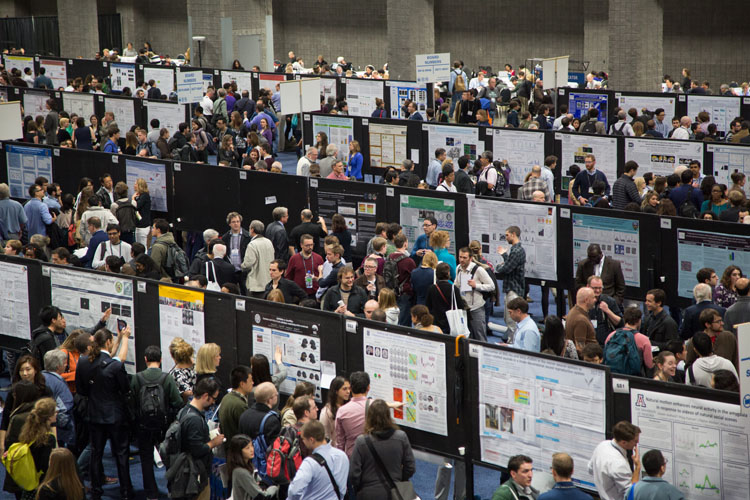
Discover the Art of Neuroscience
The Art of Neuroscience exhibit at Neuroscience 2015 showcases beautiful images of neurons, dendrites, and other brain features. Watch this video to hear from some of the artists about their inspiring designs.
Whether you’re an art enthusiast or a neuroscience lover, the fourth annual Art of Neuroscience is an exhibit that you’ll definitely want to attend. This year, seven artists will display their brain- or neurological-inspired pieces.
The Art of Neuroscience will take place from 10 a.m. to 4 p.m. Saturday, October 17, through Wednesday, October 21, in Hall A at McCormick Place.
Exhibiting artists come from all walks of life, from students to seasoned neuroscientists, and bring with them a unique perspective of the field. The artists say there’s a lot to look forward to this year that will make the showcase even better.
Greg Dunn Design
Greg Dunn, artist and owner of Greg Dunn Design, said attendees can expect to see a variety of pieces at his booth, with some depicting neural themes and specific brain regions, while others explore a broader aspect of the brain as experienced through meditative practice. Dunn said spending many hours in meditative practice over the years enhances sensitivity of senses and internal perceptions.
Dunn will display gold leaf paintings, prints, and hanging scrolls, as well as several examples of a new style of painting, called reflective microetching, which he invented with a physicist named Brian Edwards. “The purpose of this style is to use light reflecting off of gilded surfaces to make dynamic, moving images,” he explained, adding that “it’s worth seeing in person.”
Dunn, who holds a PhD in neuroscience, initially became interested in combining his love of Asian art and neuroscience when he discovered scientist Camillo Golgi’s silver staining technique, which is used to visualize nervous tissue under light microscopy.
“My making a direct connection between the universes of neuroscience and Asian art is a declaration that there is as much beauty and diversity in the microscopic world as there is in the macroscopic,” he said.
Artologica
Michele Banks, a painter/collage artist and owner of Artologica, creates neuroscience-themed accessories such as jewelry and scarves. Banks said attendees can expect some old and new creations at her booth.
“This year I’ll be back with more watercolors of brains and brain cells — but I’ve also created some silk scarves, which I think the SfN attendees will really like,” she said.
Banks said she got into neuroscience-themed art accidentally when people told her that her watercolor paintings looked like things under a microscope. She said she became fascinated as she began to learn more about science.
“As soon as you start thinking about the brain, you start thinking in metaphors,” she said. “It’s almost hard not to think of the brain as a machine, or a computer, or a garden. So with my brain paintings, I like to pull together the metaphorical side of the mind — roots, flowers, codes — and the physical side, the cells and anatomy.”
Kathleen Childress Designs
Jewelry designer Kathleen Childress’ art interprets the natural beauty and organic appeal of neurons. This year she’ll display delicate neuron pieces as well as bold, signature pendants. Childress is using new unusual agates, or ornamental stones, which she said work beautifully with the organic nature of neurons. Other designs feature silver and gold, with striped ebony and rosewood.
“I like to create that ‘unexpected’ design — and I can’t wait to see the viewers’ reactions and get their feedback,” she said.
Childress said what inspires her most is telling a story or expressing personal meaning in the pieces. “What’s so energizing about SfN is the true passion of the scientists who ask for designs that convey their specialty,” she said.
Shane Eaton
Shane Eaton, a master’s student studying nerve regeneration in Canada, uses photography to show the infinite variety of shapes and colors that neurons form. Eaton said attendees can expect regular and dynamic photos of individual cells as well as groups of neurons.
“I find their shapes can evoke a variety of imagery (e.g., fire, snow, lightning, even plants and sea creatures), and some of them even seem to be dancing, fighting or embracing each other,” he said. “I hope to show how interesting and varied neurons can be and how truly beautiful they are.”
Other Artists
Lia Cook , professor at the California College of the Arts, uses neurasthenia research for her fine art. Neurasthenia is a psychological disorder that covers a wide spectrum of symptoms, including the sensation of pain or of numbness in various parts of the body, chronic fatigue, weakness, anxiety, and fainting. Cook creates sensual woven faces to exemplify the emotional connections to memories of touch and cloth.
Justin Knight’s colorful mixed-media artwork aims to reflect the noise and static that is ever-present in life. His science-inspired art uses cognitive neuroscience and quantum physics.
Audrius Plioplys, who has been a neuroscientist for 40 years and a SfN member for 27 years, describes his artwork as neo-conceptual and a metaphorical investigation of thinking and consciousness.
To learn more about the Art of Neuroscience, visit SfN.org.






















